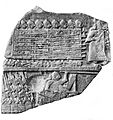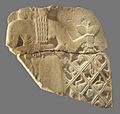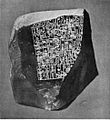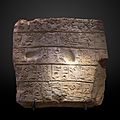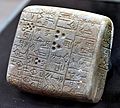Quick facts for kids Eannatum
𒂍𒀭𒈾𒁺 |
| King of Lagash |
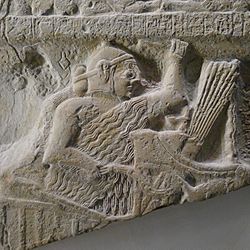
Eannatum, King of Lagash, riding a war chariot (detail of the Stele of the Vultures). His name "Eannatum" (𒂍𒀭𒈾𒁺) is written vertically in two columns in front of his head. Louvre Museum. |
| Reign |
c. 2500 BC – 2400 BC |
| Predecessor |
Akurgal |
| Successor |
En-anna-tum I |
| Dynasty |
1st Dynasty of Lagash |
Eannatum was an important ruler, known as an Ensi (which means king or governor), of the ancient city-state of Lagash. He lived around 2500 to 2400 BCE in Sumer, a region in ancient Mesopotamia. Eannatum is famous for creating one of the very first empires that historians can clearly prove existed.
He was a powerful leader who conquered many lands. He took control of Elam and destroyed its important city, Susa. He also defeated several other cities in the area that is now Iran. Eannatum made his kingdom much bigger, stretching his rule across lands like Sumer and Akkad. An old stone carving tells us that "Eannatum" was his Sumerian name. It also says he had another name, Lumma, which was his "Tidnu" or Amorite name.
Images for kids
-
Eannatum of Lagash in full dress, a modern recreation.
-
Eannatum leading his soldiers into battle. Top: Eannatum leading a group of foot soldiers. Bottom: Eannatum leading troops in a war chariot. This is a piece from the Stele of the Vultures.
-
The famous Stele of the Vultures.
-
The top part of the "mythological" side of the stele.
-
A closer look at the "battle" part of the stele.
-
A brick with Eannatum's writing on it. It talks about building a well at the Temple of Ningirsu in Lagash.
-
Eannatum's name on his Ningirsu inscription (top right corner).
-
An inscription by Eannatum, now in the British Museum.
-
A foundation stone from Eannatum, dedicated to Ningirsu, the special god of Lagash. It lists Eannatum's victories from Elam to Akshak. Now in the Louvre Museum.
-
A foundation stone of Eannatum (with its text copied).
-
The inscription Eannatum Ensi Lagashki meaning "Eannatum, Ensi of Lagash".
-
This brick shows Eannatum's victories over lands like Elam, Urua, Umma, and Ur. It also mentions building a brick well for the temple of Ningirsu.
-
A clay tablet that mentions Eannatum, prince of Lagash. Found in Iraq, around 2470 BCE. It is in the Iraq Museum.
-
A piece of a pot that mentions Eannatum, prince of Lagash. From Iraq, around 2470 BCE. It is in the Iraq Museum.
-
A small stone that mentions Eannatum, prince of Lagash. From Iraq, around 2470 BCE. It is in the Iraq Museum.
-
A stone plaque or tablet that mentions Eannatum, prince of Lagash. From Iraq, around 2470 BCE. It is in the Iraq Museum.
-
A close-up of a cuneiform inscription on a limestone object from Girsu, Iraq. It mentions Eannatum, ruler of Lagash, from 2500-2400 BCE. It is in the Ancient Orient Museum, Istanbul.
See also
 In Spanish: Eannatum para niños
In Spanish: Eannatum para niños

 In Spanish: Eannatum para niños
In Spanish: Eannatum para niños


